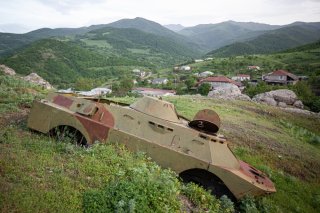Mark Temnycky

Last week, representatives from the Armenian and Azerbaijani governments met to discuss the delimitation of their borders, where they debated the Nagorno-Karabakh region. The event was the latest development in what appears to be the end of the over three-decade conflict between the two countries.
Since the late 1980s, Armenia and Azerbaijan have fought over the Nagorno-Karabakh region. To date, thousands have died in the conflict, and many more have been injured. Over the past few decades, numerous ceasefires have been implemented, and negotiations between the two countries have been ongoing. But several ceasefire violations occurred, the fighting continued, and peace talks have constantly failed. More recently, the United States and the European Union attempted to de-escalate the conflict by providing humanitarian and financial assistance. This aid, however, came to no avail, and the conflict continued. Meanwhile, Russia and Turkey brokered a ceasefire in 2020 during a renewed skirmish between Armenia and Azerbaijan. Eventually, this ceasefire was also broken, and Russia and Turkey could not lead Armenian and Azerbaijani officials to new negotiations.
Given the international community’s continued inability to achieve a peaceful resolution, the Azerbaijanis finally took matters into their own hands. First, the Azerbaijani forces established a blockade over the Lachin corridor, a pathway that connects Armenia to Nagorno-Karabakh. For nearly a year, Armenians in the region had limited access to food, medicine, and fuel. There were also reports that there were shortages in the region and that Armenians in Nagorno-Karabakh were going hungry. Then, Azerbaijani forces launched a brutal attack on the region. After a brief period of fighting, the Azerbaijanis announced that they had taken control of the territory, and thousands of Armenians began to flee the region. Now, over 100,000 ethnic Armenians are displaced.
The Armenian state is attempting to help these displaced individuals. Recently, the Armenian government approved the “procedure for determining and issuing pensions to those from Nagorno-Karabakh.” The program will seek to help ethnic Armenians displaced from Nagorno-Karabakh due to Azerbaijan’s recent attack. The pension, however, will only apply to retirement-age individuals. In addition, this form of assistance will only last until June 2024, meaning individuals will only receive this aid for six months. Finally, the financial amount of the pension will be “calculated according to local legislation,” meaning it is unclear how much financial assistance these ethnic Armenians will actually receive.
There are also further complications. First, the pension will not apply to working-aged individuals. Second, over 100,000 ethnic Armenians have fled Nagorno-Karabakh. These refugees will need food, clothing, and shelter. They will also hope to join the workforce. Given this large influx of individuals entering Armenia, it is likely that the country could “encounter substantial difficulties in meeting the needs of the displaced individuals.” This may lead to additional problems for the Armenian government. Why might this be the case?
According to the World Bank, the unemployment rate in Armenia in 2022 was 12.6 percent. In addition, the World Food Programme reported that the poverty rate in Armenia in 2022 was 27 percent. Twenty-one percent of the population was also listed as food insecure. In other words, roughly one-fourth of the country lives below the poverty line, and one-fifth of Armenians do not have sufficient access to food to meet their basic needs. Given these challenges, and with the recent influx of Nagorno-Karabakh refugees, this will likely further complicate matters for the Armenian state. Nonetheless, the government is attempting to work through these challenges so that they can take care of these individuals.
Meanwhile, Azerbaijanis are now moving into Nagorno-Karabakh. The Azerbaijani government is working to fully incorporate the region into its territory. It is unclear, however, what this reintegration effort will entail. The Azerbaijani government has also not specified how it will protect ethnic Armenians who did not flee the region during the recent onslaught. Finally, Azerbaijani officials have yet to negotiate the transfer of Nagorno-Karabakh with the Armenians. In other words, while Azerbaijan declared that it has retaken the area, there are many uncertainties about what will happen next.
Overall, the situation in and around Nagorno-Karabakh remains tense. Azerbaijani officials have stated that they have reclaimed the territory and that reintegration efforts will begin, but there is little guidance on how this will occur. Meanwhile, Armenian officials have been faced with a refugee crisis, where they are attempting to help these individuals integrate into their country. At this time, these challenges remain unresolved, and they are being pressed for time as both Armenia and Azerbaijan prepare for what may be a brutal winter.
Time is running out to help the current and displaced citizens of Nagorno-Karabakh. With the unsuccessful attempts by the international community to try and resolve the conflict, individuals from the region have sadly become victims of this forgotten war. The international community has failed them, and this injustice should not be overlooked. Such inaction cannot happen again.
No comments:
Post a Comment